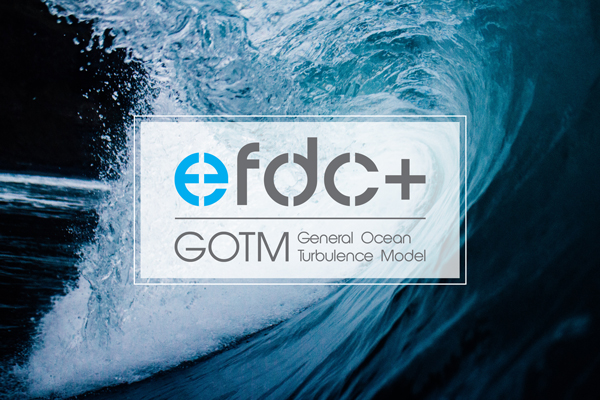Since the early development of Environmental Fluid Dynamics Code (EFDC), many new features and modules have been added to support a variety of environmental modeling capabilities. These include water quality, sediment transport, Lagrangian particle tracking, hydraulic structures, and chemical fate and transport. One element of EFDC that has seen little change in the last 20+ years is the hydrodynamic module, which serves as the foundation for all the simulation modules mentioned above. One of the key components of EFDC hydrodynamics is the approach for turbulence closure. Historically this has been limited to the famous Mellor-Yamada level 2.5 turbulence closure scheme, which uses various second-moment closure approaches by authors such as Mellor and Yamada (1982), Galperin et al. (1988), Kantha and Clayson (1994), and Kantha (2003).

We are delighted to announce that for the last several months, DSI engineers have been implementing an interface between EFDC+ and the well-known General Ocean Turbulence Model (GOTM). GOTM is a one-dimensional water column model for the most important hydrodynamic and thermodynamic processes related to vertical mixing in natural waters. Its principal authors, Hans Burchard, Karsten Bolding, and Lars Umlauf, have conceived GOTM as a library of turbulence models that can be readily interfaced with 3-D circulation models. It is a core component of other popular coastal and ocean models such as FVCOM, TELEMAC, and GETM. GOTM features an extensive list of turbulence options, and at least one member of every relevant model family can be found in GOTM, including empirical models, energy models, two-equation models, Algebraic Stress Models, K-profile parameterizations, etc.
Our partners and the EFDC modeling community can expect a variety of additional features and options, as well as an improved graphical interface in EFDC+ Explorer for hydrodynamics and the configuration of turbulence closure options using GOTM. The additional simulation capabilities offered by GOTM in EFDC+ will include the application of the k-epsilon, Mellor-Yamada, and generic length scale approaches for turbulence closure. Different options will also be available for K-Profiles Parameterization using the CVMix package (currently integrated with GOTM), as well as Langmuir turbulence, and Stokes drift. These features will offer enhanced capabilities, improved simulation accuracy, realism, and numerical stability, especially when simulating stratified systems.
DSI engineers have played a leading role in developing EFDC since the early 2000s. Our version of the code, EFDC+, is now in version 11 and is provided as open-source software under the GNU Public License version 2. This open-source licensing means that our users can share all of these new capabilities offered by GOTM in upcoming releases of EFDC+. Please feel free to contact us if you have comments or questions.
References: [1] https://gotm.net/manual/stable/pdf/letter.pdf
[2] Hamrick, John M. “User’s manual for the Environmental Fluid Dynamics Computer code.” (1996).
[3] Mellor, George L., and Tetsuji Yamada. “Development of a turbulence closure model for geophysical fluid problems.” Reviews of Geophysics 20.4 (1982): 851-875.
[4] Galperin, B., et al. “A quasi-equilibrium turbulent energy model for geophysical flows.” Journal of the atmospheric sciences 45.1 (1988).
[5] Kantha, Lakshmi H., and Carol Anne Clayson. “An improved mixed layer model for geophysical applications.” Journal of Geophysical Research: Oceans 99.C12 (1994): 25235-25266.
[6] Kantha, Lakshmi H. “On an improved model for the turbulent PBL.” Journal of the atmospheric sciences 60.17 (2003): 2239-2246.
[7] Rodi, W. “Examples of turbulence models for incompressible flows.” AIAA journal 20.7 (1982): 872-879.
[8] Umlauf, Lars, and Hans Burchard. “A generic length-scale equation for geophysical turbulence models.” Journal of Marine Research 61.2 (2003): 235-265.
[9] Li, Qing, et al. “Integrating CVMix into GOTM (v6. 0): a consistent framework for testing, comparing, and applying ocean mixing schemes.” Geoscientific Model Development 14.7 (2021): 4261-4282.
[10] Umlauf, L., H. Burchard, and K. Hutter. “Extending the k–ω turbulence model towards oceanic applications.” Ocean Modelling 5.3 (2003): 195-218.
[11] Large, William G., James C. McWilliams, and Scott C. Doney. “Oceanic vertical mixing: A review and a model with a nonlocal boundary layer parameterization.” Reviews of geophysics 32.4 (1994): 363-403


